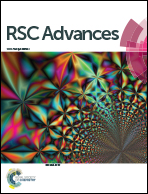In situ sonochemical synthesis of luminescent Sn@C-dots and a hybrid Sn@C-dots@Sn anode for lithium-ion batteries†
Abstract
A facile sonochemical approach is employed for the in situ formation of C-dots via ultrasonic irradiation of polyethylene glycol (PEG) solvent and its decomposition. Metallic bulk tin was added to the reaction vessel and heated to its melting point (234 °C) in the presence of polyethylene glycol 400. The two-phase mixture was sonicated to yield Sn@C-dots and subsequently to achieve Sn nanoparticles decorated with Sn@C-dots (Sn@C-dots@Sn). The fluorescence (luminescence) properties of Sn@C-dots are different from those of the C-dots alone and change as a function of excitation wavelength. The as-synthesized Sn@C-dots@Sn nanoparticles were directly deposited on the copper foil current collector as a promising anode for Li-ion batteries. Encouraging lithiation and delithiation properties are obtained with high coulombic efficiency and enhanced rate capabilities for the hybrid Sn@C-dots@Sn nanoparticles, owing to the conducting carbon dot network on the tin nanoparticles minimizing pulverization effects. Methodical studies on morphology (SEM, TEM), structure (XRD, HR-TEM) and compositions (XPS, EDS) are carried out on the Sn@C-dots and electroactive Sn@C-dots@Sn nanoparticles to understand the reaction mechanism and their luminescence and battery anode properties.


 Please wait while we load your content...
Please wait while we load your content...